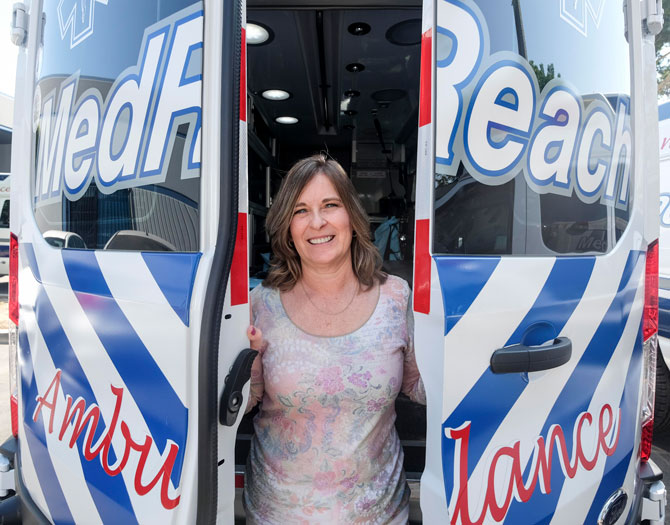
When Kathy McNab bought patient transport service MedReach Ambulance a quarter-century ago, it had only two ambulances at its beck and call.
Her company, based on a tidy tree-lined industrial street on the edge of Compton, now has two dozen ambulances crewed by more than 100 emergency medical technicians.
But MedReach’s profitability – along with the profitability of dozens of ambulance companies across Los Angeles – is under pressure as expenses spike and revenue from insurance reimbursements flatlines.
“The reimbursement is low,” McNab said of current service rates. “We don’t get what we bill. The average payment is roughly $250. Even if the rates are high, we don’t get them. And our expenses keep going up.”
MedReach is hanging on despite financial challenges, but other patient transport operators haven’t been able to survive the current conditions.
Of the 53 private ambulance services licensed in the city last year, 18 have either gone belly up or been subsumed by other ambulance companies – a 34 percent decrease – city of L.A. transportation officials said.
That leaves 35 firms within what might be the state’s largest ambulance market to shuttle nonemergency patients – the Los Angeles Fire Department handles 911 calls – from hospital to hospital, or from home to health care facility and home again.
The industry contraction is caused, at least in part, by stagnant reimbursement rates, which are set by local, state and federal regulators. The freeze has been particularly bad for L.A. operators, according to Matt Armstrong, general manager for Guardian Ambulance Service in Pasadena and president of the Los Angeles County Ambulance Association, a trade group representing 16 companies with a total fleet of roughly 1,000 ambulances.
“There are some ridiculous rates out there,” Armstrong said. “Companies are going out of business.”
Proposed hikes
There could be some relief on the way, however, because city of L.A. officials are recommending the first private ambulance rate adjustment for nonemergency patients in three years.
The new rates, which are based on a study by the city’s Transportation Department, would allow a basic life-support ambulance call charge to increase 38.6 percent to $1,000 from $722. The City Attorney’s Office is drafting an ordinance that the City Council is expected to approve as early as next month.
“Part of the concern some of the companies were having was if the cost of living were to increase, and the minimum wage, would they be able to stay in business?” said Jarvis Murray, taxicab administrator and franchise regulator for the city’s Transportation Department.
But this local rate increase is only a small Band-Aid for a much larger wound, according to ambulance industry insiders.
Leslie McNeal, vice president and treasurer for Schaefer Ambulance Service Inc. of Larchmont, said the higher charges will only apply to a shrinking population of privately insured and self-paying ambulance patients. Meanwhile, ambulance services are squeezed by a growing number of Medi-Cal and Medicare reimbursed rides that are unaffected by the proposed city ordinance.
“It will give us more money for a small percentage of our business, but it won’t help with Medicare or Medi-Cal,” McNeal said “You try to make it up in volume, but it’s very difficult.”
Growing problem
Ambulance service is divided between emergency and nonemergency transports in California, with emergency calls zoned between dozens of regions across the state, including the county.
Of the roughly 3 million patients transported within the Golden State each year, according to a statewide trade group, more than three out of four are handled by 170 private companies. The rest are tended by paramedics and emergency medical technicians from public agencies such as the Los Angeles Fire Department.
The highly regulated private ambulance industry in recent years has undergone intense consolidation, analysts said, with smaller companies closing or selling out to larger corporations as the health care landscape changed in response to the Affordable Care Act. As Medi-Cal and Medicare rolls swelled under the new law, private insurance payouts have decreased, which have long been the lifeblood of ambulance operators.
These private reimbursements have shrunk to 10 percent or less of ambulance operators’ billings, down from between 30 percent and 40 percent a few years ago, according to Ross Elliott, president of the California Ambulance Association.
That means fewer emergency advanced life-support transports worth $2,000 if charged to an insurance company, Elliott said, and more calls worth $117 if reimbursed by Medi-Cal. The average cost for such a call to an ambulance company: about $700 a patient.
These losses add up. Of the $2 billion paid each year for ambulance services statewide, ambulance services lose $165 million because of below-cost rates.
“It’s crazy, it doesn’t cover the actual cost,” Elliott said. “There’s no ability to shift those costs to make ends meet.”
Schaefer’s McNeal, who is the granddaughter of company founder Walter Schaefer, said the system has to change if private companies like her family’s hope to survive.
“From a business perspective, the rates are among the lowest in the state,” she said. “An increase, it’s badly needed. What would help most (is) if the state of California would increase the Medi-Cal reimbursement for ambulance transport. It hasn’t been changed in 20 years.”
